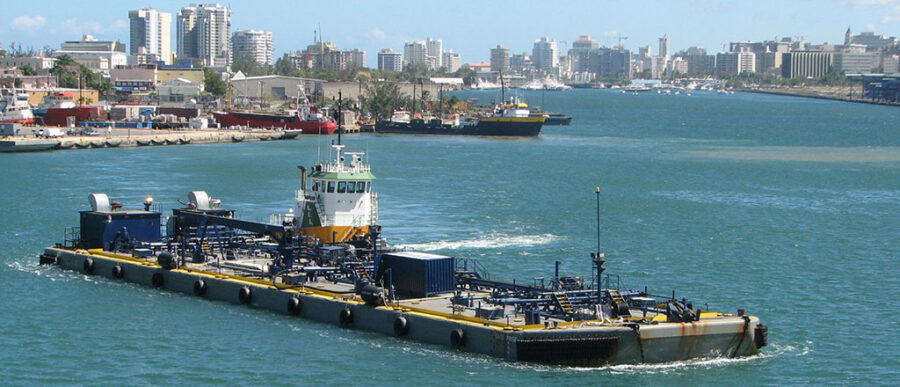Like many before him, Juan Posada Hernandez left Puerto Rico in search of a more prosperous life in New York. “I’ve had uncles, grandparents, friends…they all left,” he says. Leaving the island for a better job or education on the U.S. mainland is a tradition that dates back generations. But few who came before the current wave were fleeing an economic situation as desperate as the one that pushed Posada away. “There’s just nothing anymore,” he says of the job market. “Even the restaurant I was working in had to close because they couldn’t pay the [electricity] bill. It’s bleak.”
Unemployment sits above 14% — more than double the mainland rate. Businesses are closing in droves. The electricity authority teeters on the verge of default, which would cause the largest-ever restructuring of state or local debt. And with some 1,000 Puerto Ricans a week leaving for the U.S. mainland, a full third of people born on the island now live elsewhere — the first time that has happened since the 1700s, according to a new Pew Research report. Things are indeed “bleak” for Puerto Rico.
“Since the early 2000s, they’ve been losing ground and haven’t been able to stay competitive,” notes Mauro Guillen, a Wharton management professor. “The governments over the years over-borrowed. One was populist and the others were afraid to make tough decisions. All this is making things difficult for this current administration.”
Governor Alejandro Garcia Padilla was sworn in a year and a half ago and promptly cut government spending and reduced the deficit by more than 60%. “At the end of the day, it’s tough because there’s a lot of competition,” Guillen points out. “Puerto Rico’s biggest problem lies with the public sector. In the good old days, when growth was high, the public sector grew too much. They borrowed money to pay for all of that and that’s why they are in they position they are in.”
Yet, amid all the bad news coming out of the island, the top economic development officer is highly optimistic. Expect “5% [GDP] growth within the next three to five years,” says Alberto Baco, secretary of economic development and commerce told Knowledge at Wharton. The island’s economy hasn’t grown that fast in more than a decade, but Baco says the combination of fiscal discipline and economic incentives will again make Puerto Rico a place to invest. “The negatives are … scenes of the past. All we can present is that we’re doing the right things on the fiscal side and on the economic development side.”
The stakes are enormous. If it succeeds, the government’s plan to turn the economy around would not only reverse migration trends, it would also position the island — which is blessed with numerous economic advantages — as a destination for international businesses, something like the Singapore of the Caribbean. But before the government can restore the economy to the level of production it saw during its heyday, it needs to clear some of the most significant financial hurdles faced anywhere in the United States.
“It’s tough because there’s a lot of competition. Puerto Rico’s biggest problem lies with the public sector.” — Mauro Guillen
Lights Out?
Many trace the underlying economic problems to the Puerto Rico Electric Power Authority (PREPA). Despite charging more than double the average rate per kilowatt hour that mainland suppliers charge, PREPA slid deep into the red in recent years. The prices are so high, in part, because the authority imports oil, rather than cheaper natural gas, to fuel its electricity generating facilities.
But the authority was also structured to fail, according to Elías R. Gutiérrez, an economist and professor of planning at the University of Puerto Rico. “Let’s put it this way: PREPA has been the cause of the serious problems with the economy of Puerto Rico for several years now.”
Gutiérrez notes the authority has failed to invest in new technologies and continues to subsidize the central government even as it accumulated debt. Although it was formed as a public corporation, PREPA did not charge the government or municipalities for the electricity they consumed. Gutiérrez said the subsidy cost PREPA tens of millions a year. “There’s no way anyone, not even a monopoly, which PREPA is, can survive under those conditions.”
As a result, the authority pushed higher costs onto residents and businesses. The average rate of 26 cents per kilowatt hour compares to an average of 10 cents across the mainland U.S., according to the Energy Information Administration. That, in turn, deterred new large-scale investment and forced many small businesses, such as the restaurant where Posada worked, to close.
The subsidy helped push the authority’s debt to roughly $9 billion this year. As the bills mounted, the government passed a law in June that allows PREPA and other public corporations — which owe a combined $19.4 billion — to restructure their debts while avoiding federal bankruptcy. PREPA was able to make good to bondholders in July only by dipping into its reserve fund, which led analysts to predict it is likely to miss the January payment, forcing a restructuring.
A restructuring would be painful for bondholders, many of whom are Puerto Ricans who bought into notes as part of their retirement savings. Mainland U.S. investment funds also hold about $1.6 billion. They have filed a federal lawsuit challenging the restructuring law. A judge expects the island to present its case in September.
PREPA won a reprieve in mid-August when it reached a deal with banks to extend some $671 million in credit lines until March, PREPA said in a statement. That agreement will allow PREPA to continue buying oil and could help it stave off a restructuring, at least temporarily.
Under the agreement, PREPA must appoint a chief restructuring officer by early September and develop a long-term business plan by December. “In the next six months, restructuring [is] the most probable scenario,” says Vincente Feliciano, an economist and president of San Juan-based Advantage Business Consulting. “In my opinion, sooner rather than later would be better. As soon as possible is preferable.”
Feliciano says a default might be the best thing for the Puerto Rican economy as it would clear much of the uncertainty holding back investment. “We’re in uncharted waters. This law is new and now PREPA needs approval to raise rates,” due to the creation of a new government agency that oversees rate increases, he notes. “A rate increase is unlikely, so they are likely to default at some point. If it comes sooner, it will clear the air…. The energy situation is important to the pharmaceutical and manufacturing industries.”
“In the next six months, restructuring [is] the most probable scenario. In my opinion, sooner rather than later would be better. As soon as possible is preferable.” — Vincente Feliciano
Senales De Vida
Last month, while speculation about PREPA’s future swirled and as the New York Federal Reserve Bank released a report warning of the need for Puerto Rico to enact drastic economic reforms, Baco, the economic development officer, was nailing down the details of a handful of major investments from international corporations planning to move their regional headquarters to Puerto Rico.
He says that at least three major companies will soon announce they are relocating regional headquarters to the islands. For Baco, those announcements will be only the latest signs of life, or “senales de vida,” that the Puerto Rican economy is on the verge of making a comeback. He adds that the backbone of the island’s economy — manufacturing, pharmaceuticals and tourism — remains strong.
The manufacturing sector, once hemorrhaging jobs, has stabilized during the last 18 months, and continues to employ some 75,000 people. Baco points to the announced $9 million expansion of UTC Aerospace Systems’ Santa Isabel manufacturing plant, where 1,300 workers produce parts for the aerospace and defense industries.
Meanwhile, the number of cruise ship passengers visiting the island increased roughly 15% in the past year. And hotels are booked — the average daily room rate in Puerto Rico reached a record of $256.29 in February. Revenue per available room, which the hotel industry uses as a measure of the strength of a market, sat at an all-time high average of $99.82 last year, according to a report by the The Wall Street Journal. That’s good news for a key sector that, while down from its peak in 2008, still makes up roughly 5% of the economy.
But beyond those industries, Baco says the government is trying to push the island’s economy forward by attracting new sectors, including the information technology and services industries.
In April, the government lured Germany-based Lufthansa Technik to build a major aviation maintenance and repair facility adjacent to the Rafael Hernandez International Airport outside San Juan. The facility, which will begin servicing aircraft for at least two major airlines, including Caribbean leader JetBlue, will create as many as 600 direct jobs and support an estimated 2,000 indirect jobs, Baco notes.
“That’s a new line for Puerto Rico, a major sector that didn’t exist,” he adds. “We are globalizing our vision and we’re beginning to see international companies choosing Puerto Rico.” Baco says the government wants to promote the island’s natural advantages — the fact that it is a U.S. territory, has a bilingual workforce, and its geography and climate — to attract domestic companies that want a gateway to Latin America or Latin American companies that want an entry to the U.S.
To support new industries, the government has passed a range of financial incentives and is taking aggressive steps to improve its infrastructure. It recently launched a $17 million pilot project to bring ultra high-speed Internet to an economically important area near San Juan. The project, which threads fiber optic cable though the existing aqueducts and water pipes, will deliver network speeds of roughly one-gigabyte-per-second, 100 times faster than a typical broadband connection.
Before the government can restore the economy to the level of production it saw during its heyday, it needs to clear some of the most significant financial hurdles faced anywhere in the United States.
Giancarlo Gonzalez, the government’s chief information officer, says if the project is successful it could be replicated in other population centers across the island. “There’s a major opportunity here for the telecom sector.”
Puerto Rico already has several large tech companies, including HP and Microsoft. Gonzalez says upgrading network speeds will have economic benefits. Currently only 12% of businesses have a high-speed fiber optic connection. A 2012 study by the Inter-American Development Bank said that every 10% increase in broadband penetration in Latin America and the Caribbean “is associated with 3.19% higher GDP and 2.61% higher productivity.”
“The idea was: How do we turn Puerto Rico into tech powerhouse with a lot of capacity? The anchor plan is the aqueduct project,” Gonzalez notes.
Although it’s a long way off, the vision of the island as a highly connected destination for international business is the message that the government is pushing. “Our short version of how we describe this new economy is that we’re more competitive than Miami and we are closer to a Singapore,” Baco notes.
Overly Optimistic?
Although the government is bullish, it remains to be seen how major hurdles, such as PREPA’s restructuring, will affect the economic plan. Ratings agencies have already downgraded general obligation bonds. Residents continue to flee in droves. And much uncertainty remains among investors.
Wharton’s Guillen says the best thing that could happen to the Puerto Rican economy is a strong rebound of the U.S. economy. “The fact that the U.S. economy grew by 4% in the second quarter was good news for Puerto Rico,” he notes. “The most important factor for Puerto Rico, the most important customer base, is in the United States.”
But others are less optimistic. “We’ve had seven years of stagnation and the measures taken during the past year and a half have only provided artificial life to the Jabba the Hutt-like government that we have here,” Gutiérrez says. “What we’ve seen is not only a migration of the labor force, but the middle class has disappeared also. Savings have been decimated. We have lost a tremendous amount of wealth. And I don’t see much improvement in our future.”



